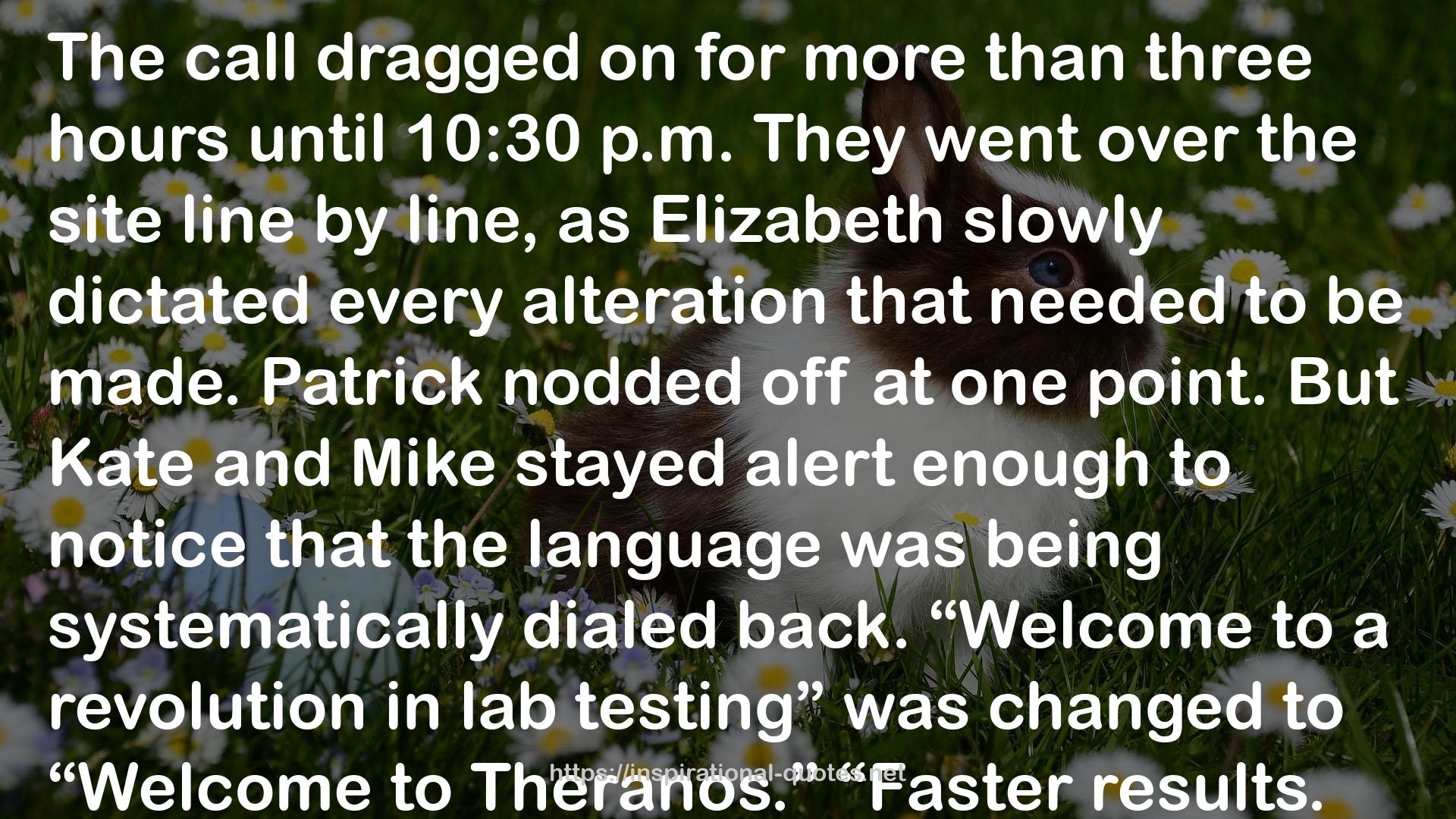63
" After they hung up, Hunter took aside Renaat Van den Hooff, who was in charge of the pilot on the Walgreens side, and told him something just wasn’t right. The red flags were piling up. First, Elizabeth had denied him access to their lab. Then she’d rejected his proposal to embed someone with them in Palo Alto. And now she was refusing to do a simple comparison study. To top it all off, Theranos had drawn the blood of the president of Walgreens’s pharmacy business, one of the company’s most senior executives, and failed to give him a test result! Van den Hooff listened with a pained look on his face. “We can’t not pursue this,” he said. “We can’t risk a scenario where CVS has a deal with them in six months and it ends up being real.” Walgreens’s rivalry with CVS, which was based in Rhode Island and one-third bigger in terms of revenues, colored virtually everything the drugstore chain did. It was a myopic view of the world that was hard to understand for an outsider like Hunter who wasn’t a Walgreens company man. Theranos had cleverly played on this insecurity. As a result, Walgreens suffered from a severe case of FoMO—the fear of missing out. "
― John Carreyrou , Bad Blood: Secrets and Lies in a Silicon Valley Startup
65
" Everywhere you look with this young lady, there’s a purity of motivation,” Shultz told him. “I mean she really is trying to make the world better, and this is her way of doing it.” Mattis went out of his way to praise her integrity. “She has probably one of the most mature and well-honed sense of ethics—personal ethics, managerial ethics, business ethics, medical ethics that I’ve ever heard articulated,” the retired general gushed. Parloff didn’t end up using those quotes in his article, but the ringing endorsements he heard in interview after interview from the luminaries on Theranos’s board gave him confidence that Elizabeth was the real deal. He also liked to think of himself as a pretty good judge of character. After all, he’d dealt with his share of dishonest people over the years, having worked in a prison during law school and later writing at length about such fraudsters as the carpet-cleaning entrepreneur Barry Minkow and the lawyer Marc Dreier, both of whom went to prison for masterminding Ponzi schemes. Sure, Elizabeth had a secretive streak when it came to discussing certain specifics about her company, but he found her for the most part to be genuine and sincere. Since his angle was no longer the patent case, he didn’t bother to reach out to the Fuiszes. — WHEN PARLOFF’S COVER STORY was published in the June 12, 2014, issue of Fortune, it vaulted Elizabeth to instant stardom. Her Journal interview had gotten some notice and there had also been a piece in Wired, but there was nothing like a magazine cover to grab people’s attention. Especially when that cover featured an attractive young woman wearing a black turtleneck, dark mascara around her piercing blue eyes, and bright red lipstick next to the catchy headline “THIS CEO IS OUT FOR BLOOD.” The story disclosed Theranos’s valuation for the first time as well as the fact that Elizabeth owned more than half of the company. There was also the now-familiar comparison to Steve Jobs and Bill Gates. This time it came not from George Shultz but from her old Stanford professor Channing Robertson. (Had Parloff read Robertson’s testimony in the Fuisz trial, he would have learned that Theranos was paying him $500,000 a year, ostensibly as a consultant.) Parloff also included a passage about Elizabeth’s phobia of needles—a detail that would be repeated over and over in the ensuing flurry of coverage his story unleashed and become central to her myth. When the editors at Forbes saw the Fortune article, they immediately assigned reporters to confirm the company’s valuation and the size of Elizabeth’s ownership stake and ran a story about her in their next issue. Under the headline “Bloody Amazing,” the article pronounced her “the youngest woman to become a self-made billionaire.” Two months later, she graced one of the covers of the magazine’s annual Forbes 400 issue on the richest people in America. More fawning stories followed in USA Today, Inc., Fast Company, and Glamour, along with segments on NPR, Fox Business, CNBC, CNN, and CBS News. With the explosion of media coverage came invitations to numerous conferences and a cascade of accolades. Elizabeth became the youngest person to win the Horatio Alger Award. Time magazine named her one of the one hundred most influential people in the world. President Obama appointed her a U.S. ambassador for global entrepreneurship, and Harvard Medical School invited her to join its prestigious board of fellows. "
― John Carreyrou , Bad Blood: Secrets and Lies in a Silicon Valley Startup
73
" Less than three months later, the walls began closing in again: on March 14, 2018, the Securities and Exchange Commission charged Theranos, Holmes, and Balwani with conducting “an elaborate, years-long fraud.” To resolve the agency’s civil charges, Holmes was forced to relinquish her voting control over the company, give back a big chunk of her stock, and pay a $500,000 penalty. She also agreed to be barred from being an officer or director in a public company for ten years. Unable to reach a settlement with Balwani, the SEC sued him in federal court in California. In the meantime, the criminal investigation continued to gather steam. As of this writing, criminal indictments of both Holmes and Balwani on charges of lying to investors and federal officials seem a distinct possibility. "
― John Carreyrou , Bad Blood: Secrets and Lies in a Silicon Valley Startup

